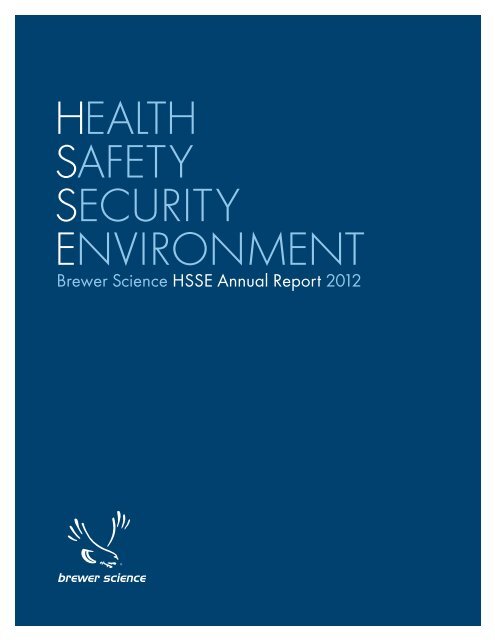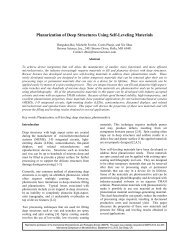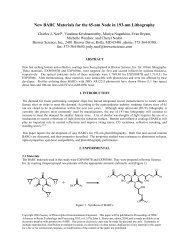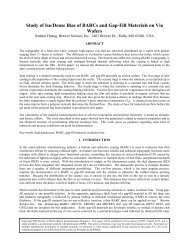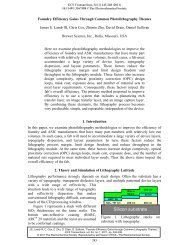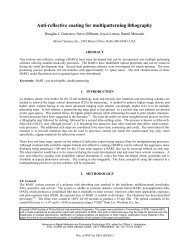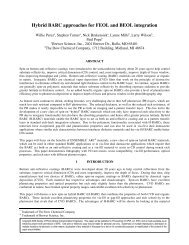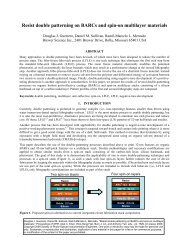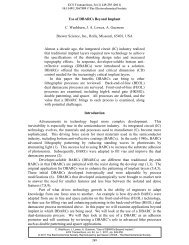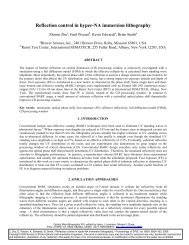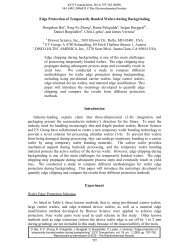HEALTH SAFETY SECURITY ENVIRONMENT - Brewer Science
HEALTH SAFETY SECURITY ENVIRONMENT - Brewer Science
HEALTH SAFETY SECURITY ENVIRONMENT - Brewer Science
You also want an ePaper? Increase the reach of your titles
YUMPU automatically turns print PDFs into web optimized ePapers that Google loves.
Health<br />
Safety<br />
Security<br />
Environment<br />
<strong>Brewer</strong> <strong>Science</strong> HSSE Annual Report 2012
Table of Contents<br />
Message from the President 2<br />
Why HSSE? 3<br />
HSSE Policy 3<br />
HSSE Performance Information 4–12<br />
Training 13<br />
Awards & Recognition 14
Message from the President<br />
For more than thirty years, our corporate vision, “Of the People, For the Customer, By the Technology,”<br />
has directed our business practices at <strong>Brewer</strong> <strong>Science</strong>. Our health, safety, security, and environmental<br />
(HSSE) management systems have promoted this vision by providing leading programs to sustain<br />
the environment in which our company operates. We drive continuous improvement of our HSSE<br />
systems through implementation of the ISO ® 14001 and OHSAS 18001 standards, guidance by<br />
the ISO ® 27002 standard, and vigilant communication with customers through personal contacts,<br />
involvement with semiconductor industry associations, and interactive web communication.<br />
<strong>Brewer</strong> <strong>Science</strong> has been externally reporting environmental, safety, and health performance on<br />
a yearly basis since 2006. We provide this report to our stakeholders to better communicate the<br />
continued importance we place on green technology, business sustainability and safety, and their<br />
value to our company, the environment, and the community.<br />
<strong>Brewer</strong> <strong>Science</strong> is proud of the positive effects our HSSE initiatives and efforts have had on our internal<br />
and external communities. 2011 was another premier year for driving change through aggressive goals<br />
and objectives. We worked over 2.1 million hours without a lost-time injury, implemented heightened<br />
security processes, and continued to improve our employee wellness programs. These achievements<br />
are testaments that the global safety, security, and wellness policies we provide bring awareness and<br />
well-being to our employees. Internal controls help us maintain productivity growth and lean resource<br />
management. Over the past 9 years, our recycling efforts have diverted over 375 tons of waste<br />
from landfills. Partnership collections have helped the community properly dispose of over 344 tons<br />
of waste over the last 9 years. We also continue emergency response drills with our local fire and<br />
emergency management departments.<br />
We continually seek ways to improve and always welcome your feedback. It is our sincere desire that<br />
these efforts will have a positive impact on the overall health, safety, security, and environment of the<br />
global communities that we influence.<br />
Dr. Terry <strong>Brewer</strong><br />
President and Founder, <strong>Brewer</strong> <strong>Science</strong>, Inc.<br />
— 2 —
Why HSSE?<br />
<strong>Brewer</strong> <strong>Science</strong> recognizes its responsibility to conserve natural resources while providing safe,<br />
secure, and environmentally responsible solutions for customers throughout the world. For this reason,<br />
health, safety, security, and environmental (HSSE) management systems based on the requirements of<br />
the ISO ® 14001, OHSAS 18001, and ISO ® 27002 standards are maintained. A global HSSE Team<br />
implements and maintains systems that support the company’s HSSE policy and goals. Internal Safety,<br />
Security, and Environmental Departments participate with and assist the HSSE Team by educating<br />
employees and the local community about improved waste management and HSSE practices.<br />
HSSE Policy<br />
<strong>Brewer</strong> <strong>Science</strong> has established and is committed to maintaining health, safety, security, and<br />
environmental management systems with the overall objective of preventing pollution of the environment<br />
and providing a healthy, safe, and secure workplace. Suppliers, contractors, and customers are<br />
encouraged to follow ISO ® 14001, OHSAS 18001, and ISO ® 27002 standards. These systems will<br />
drive continuous improvement through planning, risk assessment and monitoring, corrective action, and<br />
management review. <strong>Brewer</strong> <strong>Science</strong> will comply with all relevant international, federal, state, and<br />
local regulations and other requirements wherever we operate.<br />
— 3 —
HSSE Performance Information<br />
All environmental, health, and safety aspects of <strong>Brewer</strong> <strong>Science</strong> processes and products are identified.<br />
Objectives and targets that minimize the company’s negative impact on these aspects are then<br />
developed. Management approves the objectives, while the HSSE Team manages the systems to<br />
ensure all goals are reached effectively and on time.<br />
Operational Objectives<br />
The following specific objectives have been chosen to minimize environmental, health, security, and<br />
safety impacts:<br />
• Enhance global intellectual property security by December 2012<br />
• Integrate security management system software by December 2015<br />
• Integrate a job safety analysis program by June 2012<br />
• Implement a multiyear Green Program through December 2015<br />
Wellness<br />
Healthy employees must be at the helm to carry out the <strong>Brewer</strong> <strong>Science</strong> company vision, “Of the<br />
People, For the Customer, By the Technology.” Several wellness programs were provided for<br />
employees during 2011:<br />
• Walking program - Hike the Oregon Trail<br />
• Biggest Loser program<br />
• Various nutritional brown bag luncheons<br />
• Smoking cessation program<br />
• Discounts for employees at various fitness centers<br />
• On-site treadmill and elliptical machines<br />
• Healthy food options in the vending machines<br />
• On-site yoga classes<br />
— 4 —
Number of OSHA ® Recordable Injuries<br />
16<br />
14<br />
12<br />
10<br />
8<br />
6<br />
4<br />
2<br />
0<br />
2006 2007 2008 2009 2010 2011<br />
OSHA Injuries<br />
Injuries Requiring First Aid<br />
<strong>Brewer</strong> <strong>Science</strong> experienced only one minor first aid injury in 2011. The <strong>Brewer</strong> <strong>Science</strong> safety record<br />
continues to exceed the semiconductor industry average by being over 2,200,000 hours without a<br />
lost-time injury.<br />
3.0<br />
OSHA ® Recordable Injuries Rate Comparisons<br />
(U.S. Bureau of Labor Statistics)<br />
Injury Rate (Per 100 Employees)<br />
2.5<br />
2.0<br />
1.5<br />
1.0<br />
0.5<br />
0.0<br />
2006 2007 2008 2009 2010 2011<br />
<strong>Brewer</strong> <strong>Science</strong> (0.4) Semiconductor Industry Avg. (1.6)<br />
— 5 —
Tons Recycled<br />
70<br />
60<br />
50<br />
Tons<br />
40<br />
30<br />
20<br />
10<br />
0<br />
2007 2008 2009 2010 2011<br />
<strong>Brewer</strong> <strong>Science</strong> has recycled nearly 375 tons of materials since its formal recycling program was<br />
initiated in 2002. Materials included in these numbers are all types of paper, plastic bags, shrinkwrap,<br />
bottles, and containers. The proceeds from recycling aluminum cans, cell phones, and ink-jet<br />
cartridges are donated to local non-profit organizations. Batteries, steel drums, and other metals are<br />
also recycled. <strong>Brewer</strong> <strong>Science</strong> continually looks for ways to utilize recyclable materials.<br />
Annual Paper Usage Per Employee<br />
6.00<br />
5.50<br />
Reams<br />
5.00<br />
4.50<br />
4.00<br />
2006 2007 2008 2009 2010 2011<br />
When possible, employees utilize electronic images rather than printing paper copies to reduce paper<br />
consumption.<br />
— 6 —
Diversion Rate of Solid Waste<br />
70%<br />
60%<br />
50%<br />
40%<br />
30%<br />
20%<br />
10%<br />
0%<br />
2006 2007 2008 2009 2010 2011<br />
Cubic Yards<br />
Pounds<br />
<strong>Brewer</strong> <strong>Science</strong> sustained the percentage of total solid waste diverted from landfills.<br />
$35<br />
Annual Solid Waste Disposal Cost Per Employee<br />
$30<br />
$25<br />
U.S. Dollars<br />
$20<br />
$15<br />
$10<br />
$5<br />
$0<br />
2006 2007 2008 2009 2010 2011<br />
Solid waste disposal costs decreased as recycling tonnage increased.<br />
— 7 —
Hazardous Waste Disposal<br />
250,000<br />
200,000<br />
Pounds<br />
150,000<br />
100,000<br />
50,000<br />
0<br />
2008 2009 2010 2011<br />
Fuel Blending Neutralized/Landfilled Metal Recovery<br />
Fuel blending involves processing hazardous waste into fuels derived from liquid and solid waste,<br />
which are used as a secondary fuel source to replace coal and natural gas in cement kilns. This method<br />
is safe and effective for recovering the energy value of the waste and helps conserve our planet’s finite<br />
natural resources.<br />
Metal drums are processed as they pass through the Container Decontamination Unit, an oven fueled<br />
by natural gas with temperatures above 1500°F. The high temperatures destroy the chemical residues,<br />
which produce ash. This ash is tested and blended on site into an alternative fuel source for cement<br />
kilns. Decontaminated drums are then crushed and sent to steel mills for recycling.<br />
— 8 —
Green Program<br />
35000<br />
Running Conservation Totals (FEU)<br />
30000<br />
25000<br />
20000<br />
15000<br />
10000<br />
5000<br />
0<br />
2010 2011 2012 2013 2014 2015<br />
FEU CONSERVATION GOAL<br />
FEU CONSERVATION ACTUAL<br />
The goal of this project, which began in 2010 and ends in 2015, is to reduce water, electricity, and<br />
natural gas use each by 10,000 functional equivalent units (FEU), for a total of 30,000. The 30,000<br />
FEUs are equal to 700,000 gallons per year, 25,000 kWh per year, and 10,000 therms per year<br />
by the end of 2015. Based on 250 employees, 2800 gallons of water, 1000 kWh of electricity, and<br />
40 therms of natural gas would be conserved per employee per year by 2015. This goal will be<br />
achieved through the installation of more efficient water and electrical fixtures and insulation projects.<br />
By the end of 2011, we achieved 50% of our overall program goal.<br />
— 9 —
Water Usage<br />
7500<br />
Gallons (×1000)<br />
6000<br />
4500<br />
3000<br />
1500<br />
0<br />
2008 2009 2010 2011<br />
Electricity Usage<br />
8500<br />
8000<br />
7500<br />
kWh (×1000)<br />
7000<br />
6500<br />
6000<br />
5500<br />
5000<br />
4500<br />
4000<br />
2008 2009 2010 2011<br />
— 10 —
Gas Usage<br />
150<br />
CCF (×1000)<br />
100<br />
50<br />
0<br />
2008 2009 2010 2011<br />
Global Utilities Usage<br />
8000<br />
7000<br />
6000<br />
5000<br />
4000<br />
3000<br />
2000<br />
1000<br />
0<br />
2008 2009 2010 2011<br />
Water (×1000 gallons) Electricity (×1000 kWh) Gas (×1000 CCF)<br />
— 11 —
Community Waste Collections<br />
100,000<br />
90,000<br />
80,000<br />
70,000<br />
Pounds<br />
60,000<br />
50,000<br />
40,000<br />
30,000<br />
20,000<br />
10,000<br />
0<br />
2008 2009 2010 2011<br />
<strong>Brewer</strong> <strong>Science</strong> continues its partnership with the community by helping stakeholders properly dispose<br />
of waste and adopting the surrounding streets in our industrial park. By working with the City of Rolla,<br />
the Ozark Rivers Solid Waste Management District, the Missouri Department of Natural Resources,<br />
the Meramec Regional Planning Commission, and the Phelps County Commission, <strong>Brewer</strong> <strong>Science</strong><br />
provides area residents with community collections that have enabled Phelps County to properly<br />
dispose of almost 689,000 pounds of waste over the past 9 years. This partnership contracted<br />
disposal companies and provided volunteers who collected appliances, electronics, and tires from<br />
area residents. These items would have otherwise been disposed of in a landfill. <strong>Brewer</strong> <strong>Science</strong><br />
continues to support these efforts.<br />
— 12 —
Training<br />
All personnel are required to be competent when they perform tasks that may impact HSSE issues in<br />
the workplace. Competence is defined in terms of appropriate education, training, and/or experience.<br />
Training requirements are based upon the specific task requirements of individual job descriptions<br />
and/or homogeneous exposure groups as defined in our Hazard Assessment Procedure. Training<br />
plans are updated and documented at least annually as part of the HSSE objectives planning process<br />
and are summarized in the Corporate Training Matrix. Human Resources maintains these records<br />
according to the Training Process.<br />
Below are some of the required HSSE training courses:<br />
• Hazard Communication Annual Refresher<br />
• Hazard Waste Annual Refresher<br />
• Lockout/Tagout Authorization<br />
• Workplace Violence Prevention<br />
• Fire Extinguisher Training<br />
• Flammable and Combustible Liquids Training<br />
• Influencing Security-Compliant Behaviors<br />
• Emergency Response<br />
• Safety Review & Lab Chemical Hygiene Plan<br />
• Hot Work Permits<br />
• Respirator Training<br />
• Electrical Safety<br />
• Gas Cylinder Handling<br />
• Compressed Gas<br />
• Ergonomics<br />
• Manual Handling<br />
• Elevated Work<br />
— 13 —
Awards and Recognition<br />
<strong>Brewer</strong> <strong>Science</strong> has received numerous awards in recognition of its voluntary efforts and genuine<br />
concern for the environment.<br />
Local<br />
• 2000, 2002, 2003 — Ozark Rivers Solid Waste Management District: Outstanding Contribution<br />
in Solid Waste Management<br />
• 2004 — A Community Organization to Restore Nature (ACORN): Appreciation for Beautification<br />
State<br />
• 2002 — Missouri Waste Control Coalition: Outstanding Achievement Award in the Business<br />
category<br />
• 2004 — Missouri Recycling Association: Outstanding Business Recycling/Waste Reduction<br />
Program<br />
• 2011 — Missouri Association of Manufacturers 2011 Safety Excellence Award for<br />
Category V: 400,000 or more hours worked. <strong>Brewer</strong> <strong>Science</strong>’s performance record<br />
exemplifies an outstanding safety program.<br />
National<br />
• 2004 — Export Achievement Award: U.S. Department of Commerce<br />
• 2005 — National Recycling Coalition: Fred Schmitt Award for Outstanding Corporate Leadership<br />
• 2006 — American Forest & Paper Association ® : Business Leadership and Recycling Award<br />
• 2010 — National Safety Council: Million Work Hours Award<br />
• 2010 — National Safety Council: Significant Improvement Award<br />
• 2010 — National Safety Council: Milestone Award<br />
• 2010 — Southwest Area Manufacturers Association: Safety Excellence Award<br />
• 2011 — Travelers Insurance Safety Award for working 1.5 million hours without a lost workday<br />
injury<br />
— 14 —
© 2012 <strong>Brewer</strong> <strong>Science</strong>, Inc.<br />
2401 <strong>Brewer</strong> Drive • Rolla, MO 65401 USA<br />
Phone: +1-573-364-0300 • Fax: +1-573-368-3318<br />
<strong>Brewer</strong> <strong>Science</strong> is a registered trademark of <strong>Brewer</strong> <strong>Science</strong>, Inc.<br />
ISO is a registered trademark of the International Organization for Standardization<br />
OSHA is a registered trademark of the Occupational Safety and Health Administration, U.S. Department of Labor<br />
American Forest & Paper Association is a registered trademark of the American Forest & Paper Association, Inc.<br />
www.brewerscience.com


